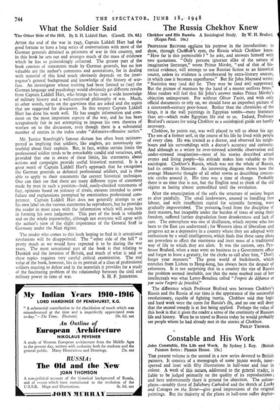Constable and His Work
John Constable, His Life and Work. By Sydney J. Key. (British Painters Series : Phoenix House. 15s.) THE present volume is the second in a new series devoted to British painters. It consists of a monograph of some 30,000 words, inter- spersed and inset with fifty illustrations in half-tone and four in
colour. A work of this nature, addressed to the general reader, is liable to be judged primarily on the quality of its reproductions ; and here unfortunately there is ground for objection. The colour- plates—notably those of Salisbury Cathedral and the sketch of Locks and Cottages on the Stour—give good impressions of the original paintings. But the 'majority of the plates in half-tone suffer deplor- ably from extreme reduction in size. The original measurements are nowhere given, and so it is impossible for the reader to make the necessary adjustments of scale without reference to catalogues. It is not over-pedantic to stress this criticism, for while familiarity with the originals can translate these snapshot-size reproductions into tolerable images of the paintings themselves, the reader who is not so fortunately equipped will find it difficult to obtain more than a very vague idea from them. Constable suffers particularly from such treatment ; his broad and free effects are often entirely lost when they are glimpsed through the wrong end of a telescope. The text provides an accurate and, for the most part, a readable account of Constable's life and work. It is a virtue in the writer that he has been content to allow Constable to tell a considerable amount of the story in his own words, in extracts from his letters to his friend John Fisher and others ;for he had a literary gift only inferior in degree to his genius as a painter. Mr. Key's monograph is in general based upon C. R. Leslie's Memoirs—one of the most attractive biographies in the language. He has also incorporated extracts from contemporary newspaper criticism, and has made use of the further information which came to light with the discovery of Farington's diary. If the final result is less interesting and less human than Leslie's classic work, this is hardly surprising. Mr. Key has not set himself the task of recreating a personality in the sense that Leslie, Constable's friend, succeeded in doing so. Although he has faithfully outlined the main biographical facts, his attention has been more specifically directed to the development of Constable's style and technique ; and such writing requires to be artfully and imaginatively done if it is to avoid the occasional charge of flatness. It is not that the author's style is bad, but rather that it is not always sufficiently distinguished to support the burden of many of the clichés of art-history. The final chapter, entitled The Artist's Legacy, traces the influence of Constable's discoveries upon his successors in England and France. Apart from giving interesting information concerning friends and pupils, the author shows how Constable's true heirs were the painters of the Barbizon school, and through them the Impres- sionists. Constable is thus placed in his correct relation to the nineteenth-century European tradition. JONATHAN MAYNE.



































 Previous page
Previous page